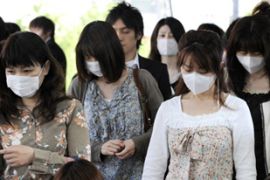Health experts fear H1N1 flu spread
Virus likely to continue rapid spread across globe, World Health Organisation warns.

The virus continues to spread, however, with Japan confirming on Monday that 125 people – many of whom had not been abroad – had become infected.
Chile reported three new cases on Monday, adding to its first two cases reported on Sunday. And tests confirmed the first case in Greece, while New York City recorded its first death from the virus.
WHO raised its global pandemic alert level last month to five on a six-point scale.
Watching Japan
| Special report |
 |
The UN agency has said it is watching the situation in Japan closely, but it was not clear yet whether the outbreak, the largest outside the Americas, would trigger a move to level six.
Under WHO rules, signs that the disease is spreading in a sustained way in a second region of the world would prompt a declaration that a full pandemic is under way.
Besides the Americas, other large clusters have been seen in Spain and Britain.
A WHO designation of a full pandemic would put countries on even higher alert about the flu strain and give more impetus to pharmaceutical efforts to fight it.
Chan and Ban Ki-moon, the UN secretary-general, are to meet pharmaceutical executives on Tuesday to discuss their ability to make vaccines to fight the strain.
| H1N1: At a glance |
|
Forty countries have confirmed about 8,800 cases Annual influenza epidemics are thought to result in three to five million cases of severe illness and between 250,000 and 500,000 deaths around the world, WHO says |
Delegates to the World Health Assembly will seek an agreement on how samples of the virus should be handled and shared with pharmaceutical companies.
However, rich and poor countries remain at odds over whether the biological material can be patented.
The meeting will also discuss poor countries’ needs for antiviral drugs such as Roche and Gilead Sciences’ Tamiflu and GlaxoSmithKline’s Relenza and any vaccines developed to confront the new flu strain.
Chan also raised the spectre of H1N1 mixing with the H5N1 avian flu virus entrenched in poultry in several countries.
“No one can say how this avian virus will behave when pressured by large numbers of people infected with the new H1N1 virus,” she said.
Young victims
US health officials also expressed concern about who the H1N1 virus was infecting – mostly children, teens and young adults – and outbreaks in schools.
Anne Schuchat of the US Centres for Disease Control and Prevention, said most of the 200 or so Americans hospitalised with the strain were young, as opposed to the elderly who are usually hardest hit by seasonal flu.
“That’s very unusual, to have so many people under 20 to require hospitalisation, and some of them in [intensive care units],” Schuchat said.
“We are also seeing outbreaks in schools, which is extremely unusual for this time of year,” she added.
New York City health officials said 16 schools were closed there due to outbreaks.
And most of Japan’s new infections were among high school students in the western prefectures of Hyogo and Osaka who had not travelled abroad, the health ministry said.
